Cabs for those Arabian nights
Page 48
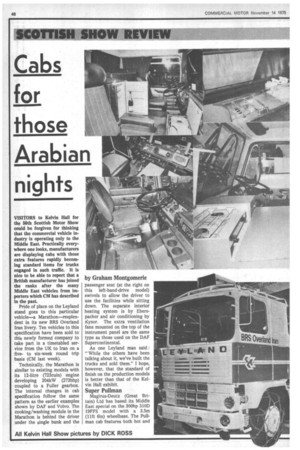
Page 49

Page 50
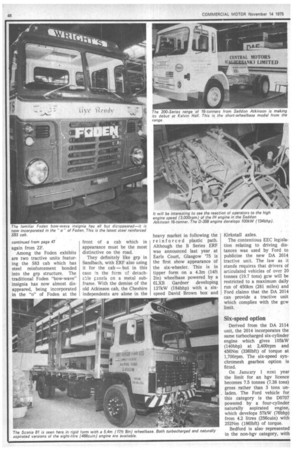
Page 51
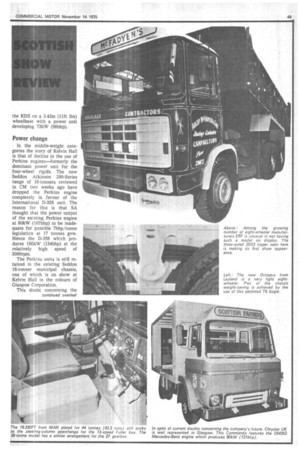
Page 52
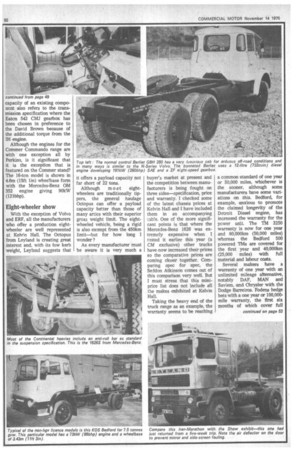
Page 55
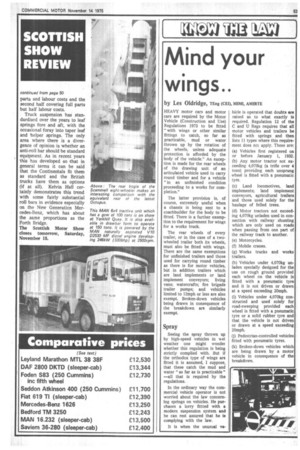
If you've noticed an error in this article please click here to report it so we can fix it.
by Graham Montgomerie
VISITORS to Kelvin Hall for the 50th Scottish Motor Show could be forgiven for thinking that the commercial vehicle industry is operating only to the Middle East. Practically everywhere one looks, manufacturers are displaying cabs with those extra features rapidly becoming standard items for trucks engaged in such traffic. It is nice to be able to report that a British manufacturer has joined the ranks after the many Middle East vehicles from importers which CM has described in the past.
Pride of place on the Leyland stand goes to this particular vehicle—a Marathon—resplendent in its new BRS Overland Iran livery. Ten vehicles to this specification have been sold to this newly formed company to take part in a timetabled service from the UK to Iran on a fiveto six-week round trip basis (CM last week).
Technically, the Marathon is similar to existing models with its 12-litre (723cuin) engine developing 204kW (273bhp) coupled to a Fuller gearbox. The internal changes in cab specification follow the same pattern as the earlier examples shown by DAF and Volvo. The cooking/washing module in the Marathon is behind the driver under the single bunk and the passenger seat (at the right on this left-hand-drive model) swivels to allow the driver to use the facilities while sitting down. The separate interior heating system is by Eberspacher and air conditioning by Kysor. The extra ventilation fans mounted on the top of the instrument panel are the same type as those used on the DAF Supercontinental.
As one Leyland man said : "While the others have been talking about it, we've built the trucks and sold them." I hope, however, that the standard of finish on the production models is better than that of the Kelvin Hall exhibit.
Super Pullman
Magirus-Deutz (Great Britain) Ltd has based its Middle East special on the 300hp 310D 19FFS model with a 3.5m (lift Bin) wheelbase. The Pullman cab features both hot and :old water supplied by electric nimps to a stainless steel sink init.
The Magirus is also fitted with some extra security derices including anti-theft lockng plates on the wheels and L device which gives the per;on who unlocks the door a ew seconds only to switch off in alarm system. If that person s the driver who knows where he controlling switch is, this time is adequate. If it is a "person or persons unknown" then the alarm will sound seconds after the door is opened.
A couple of features on the Magirus caught my eye. One was the provision of a coupling light which pivots so that it can also be used as an emergency inspection light when the cab is tilted. The other point was the specification of propane gas for the cooker because of its lower freezing point Fri extreme cold.
The power unit of the 310D 19FFS is a 14.7-litre (897cuin) V8 engine—air-cooled, of course—which develops 224kW (301bhp) at 2,650rprn. The maximum torque of 920Nm (6761bft) is constant between 1300-1600rpm. The power is transmitted via a Fichtel and Sachs single-dry-plate clutch of 380mm (15in) in diameter to an eight-speed range-change ZF gearbox.
The last " new " Middle East truck came from Saviem and, by an excellent piece of public relations technique, it was featured on Scottish television the day before the Show opened. The basic truck is the Saviem SM340—a model not previously available in the UK. The engine is a V8 of 15.45 litres (942cuin) capacity which is quoted at 747kW (335bhp) SAE at 2,200rpm — approximately 210kW (282bhp) to 13S AU 141a rating. The gearbox is a 10speed Saviem synchromesh unit controlled as usual by a steering-column lever.
The French truck is similar to the Volvo in that the cooking and washing facilities are not situated under the bunk behind the driver—but there the similarity ends. Whereas the Volvo has the equipment occupying the passenger space, the Saviem has the cooker/sink unit installed in the middle of the cab, built in line with the flat top of the engine cowl. The water is pumped into the sink via a foot-operated pump situated on the passenger side (the right in this case). As one visitor to the Show commented: "Typical of a French truck!" — referring to the storage facilities in the cab for tall bottles. Saviem had kept .up the joke by partly filling the food cabinet with onions.
Mindful of the amount of paperwork carried by drivers on transcontinental and Middle East runs, a useful compartment for papers is provided in the shelf above the windscreen. The document shelf is within easy reach of the driver.
Sleeper-cab unveiled
Although it was exhibited at Earls Court last year in prototype form, this is the first public appearance of the sleeper-cab version of the Seddon Atkinson 400 Series. The production cab differs little from the Earls Court prototype, although a fitted suitcase — installed under the bunk on the nearside — is now a standard feature. The power unit for the Show model is an NHC-250 Cummins producing 170kW (228bhp) while the gearbox is a Fuller Roadranger RTO9509A.
The complete sleeper-cab specification for the Seddon Atkinson includes exterior storage lockers, a five-position roof hatch and the rear windows blanked out with fully insulated panels.
Another first-timer at Kelvin Hall is the right-hand-drive version of the Scania 81, first announced at Frankfurt a few weeks ago. The Show model is a 5.4m (17ft 8in) wheelbase rigid powered by the natur ally aspirated D8 engine of eight litres (488cuin) capacity which gives 108kW (145bhp) to BS AU 141a.
Still on the subject of heavies — with a vengeance — the 100 tons. 6x4 MAN has a cab with a feature claimed to assist the driver in tight manoeuvring situations. This is a cab door which slides back rather than hinges outwards. Thinking of some of the more inaccessible loading bays that some drivers are required to reverse into, I wonder if this is an idea which could catch on with more normal specification trucks. I say " normal " as some of the features of this 38.330 FDA model justify the nickname of "Jumbo." The VIO engine develops 246kW (330bhp) and the truck is also available in draWbar form for operation at 150 tcns gtw.
Pickfords have just bought three of the 6x4 tractive units. Automatic transmission is a rarity in Glasgow, but the Jumbo features a ZF Transmatic torque converter coupled to a synchromesh gearbox, again from ZF.
Among the Foden exhibits are two tractive units featuring the S83 cab which has steel reinforcement bonded into the grp structure. The traditional Foden "bow-wave" insignia has now almost disappeared, being incorporated in the "o" of Foden at the front of a cab which in appearance must be the most distinctive on the road.
They definitely like grp in Sandbach, with ERF also using it for the cab—but in this case in the fcrm cf detachable panels on a metal subframe. With the demise of the old Atkinson cab, the Cheshire independents are alone in the heavy market in following the reinforced plastic path. Although the B Series ERF was announced last year at Earls Court, Glasgow '75 is the first show appearance of the six-wheeler. This is in tipper form on a 4.3m (14ft 2in) wheelbase powered by a 6LXB Gardner developing 137kW (184bhp) with a sixspeed David Brown box and Kirkstall axles.
The contentious EEC legislation relating to driving distances was used by Ford to publicise the new DA 2014 tractive unit. The law as it stands requires that drivers of articulated vehicles of over 20 tonnes (19.7 tons) gcw will be restricted to a maximum daily run of 450km (281 miles) and Ford claims that the DA 2014 can provide a tractive unit which complies with the gcw limit.
Six-speed option
Derived from the DA 2114 unit, the 2014 incorporates the same turbocharged six-cylinder engine which gives 105kW (140bhp) at 2,400rpm and 456Nm (3361bft) of torque at 1,700rpm. The six-speed synchromesh gearbox option is fitted.
On January 1 next year the limit for an hgv licence becomes 7.5 tonnes (7.38 tons) gross rather than 3 tons unladen. The Ford vehicle for this category is the D0707 powered by a four-cylinder naturally aspirated engine, which develops 57kW (76bhp) from 4.2 litres (256cuin) with 252Nm (1861bft) of torque.
Bedford is also represented in the non-hgv category, with the KDS on a 3.43m (lift 3in) wheelbase with a power unit developing 73kW (98bhp).
Power change
In the middle-weight categories the story of Kelvin Hall is that of decline in the use of Perkins engines—formerly the dominant power unit for the four-wheel rigids. The new Seddon Atkinson 200-Series range of 16-tonners reviewed in CM two weeks ago have dropped the Perkins engine completely in favour of the International D-358 unit. The reason for this is that SA thought that the power output of the existing Perkins engine at 80kW (107hhp) to be inadequate for possible 7bhp/torine legislation •at 17 tonnes gvw. Hence the D-358 which produces 100kW (134bhp) at the relatively high speed of 300Orpm.
The 'Perkins units is still retained in the existing Seddon 16-tanner municipal chassis, one of which is on show at Kelvin Hall in the colours of Glasgow Corporation.
This doubt concerning the capacity of an existing component also refers to the transmission specification where the Eaton 542 CMJ gearbox has been chosen in preference to the David Brawn 'because of the additional torque from the IH engine.
Although the engines for the Cornmer Commando range are with • one exception all by Perkins, is it Significant that it is the exception that is featured on the ,Commer stand? The 16-ton model is Shownin 4.6m (15ft 1,in) wheeljba,se form with the Mercedes-Benz OM 352 engine giving 90kW (121bhp).
Eight-wheeler show
With the exception of Volvo and ERF, all the manufacturers Who offer a production eightWheeler are well represented at Kelv:n Hall. The Ottopus from Leyland is creating great interest and, with its low kerb weight, Leyland suggests that it offers a payload capacity not far ,shart of 22 tons.
Although most eightwheelers are traditionally tippers, the general haulage Octopus can offer a payload capacity better than those of many artics With their superior gross weight ihnit. The eightwheeled vehicle, being a rigid is also exempt from the 450km limitbut for how long I wonder ?
As every manufacturer must be aware it is very much a buyer's market at present and the competition between manufacturers is being fought on three sides—specification, price and warranty. I checked some of the latest chassis prices at Kelvin Hall and I have included them in an accompanying ,`..able. One of the more significant points is that Where the Mercedes-Benz 1626 was extremely expensive When I tasted it earlier this year (a CM •exclusive) other trucks have now increased their prices so the comparative prices are coming closer together. Comparing spec for spec, the Seddon Atkinson comes out of this comparison very well. But I must stress that this miniprice list does not include all . the makes eottibited at Kelvin Hall.
Taking the heavy end of the truck range as an example, the warranty seems to be reaching a common standard of one year or 50,000 miles, .whichever is the sooner, although some manufacturers have some variations on this. Bedford, for example, anxious to promote the claimed kmgeViity of the Detroit Diesel engine, has increased the warranty for the power unit. The TM 3250 warranty 'is now for one year and 80,000km (50,000 mules) Whereas the Bedford 500 powered TMs we covered for the first year and 40,000km (25,000 miles) With full material and labour costs.
Several makers have a warranty of one year With an unlimited mileage alternative, notably DAF, MAN and Saviem, and Chrysler with the Dodge 'Barreiro's. Fodens hedge bets With a one year or 100,000 mile warranty, the first six months of which cover full parts and :labour costs and the second half covering full parts but half labour costs.
Truck suspension has standardised over the years to leaf springs fore and aft, with the occasional foray into 'taper leaf and 'helper springs. The only area where there is a divergence of opinion is whether an anti-roll bar should 'be standard equipment. As in recent years this has developed so that in general terms it can be said that the Continentals fit them as standard and the British trucks have them as options Of at all). Kelvin Hall certainly demonstrates this trend with some fairly substantial roll bars in evidence especially on the New 'Generation Mercedes-Benz, which has about the ,same proportions as the Forth Bridge.
The Scottish Motor Show closes tomorrow, Saturday, November 15.
This MAN 6x4 tractive unit which has a gcw of 100 tons is on show at Yorkhill Quay. It is also available in drawbar form to operate at 150 tons. It is powered by the MAN naturally aspirated V10 D2530 MF diesel engine developing 246kW (330bhp) at 2500rpm.




























































































































